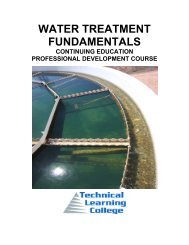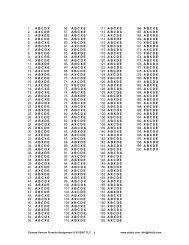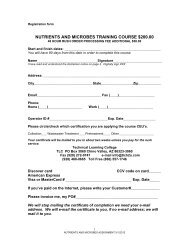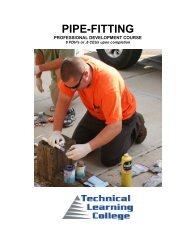Pump Primer 1 $100 - 8 Hours - Technical Learning College
Pump Primer 1 $100 - 8 Hours - Technical Learning College
Pump Primer 1 $100 - 8 Hours - Technical Learning College
You also want an ePaper? Increase the reach of your titles
YUMPU automatically turns print PDFs into web optimized ePapers that Google loves.
Burgomeister of Magdeburg<br />
The remarkable Otto von Guericke (1602-1686), Burgomeister of Magdeburg, Saxony, took up<br />
the cause, making the first vacuum pump, which he used in<br />
vivid demonstrations of the pressure of the atmosphere to the<br />
Imperial Diet at Regensburg in 1654. Famously, he evacuated<br />
a sphere consisting of two well-fitting hemispheres about a foot<br />
in diameter, and showed that 16 horses, 8 on each side, could<br />
not pull them apart. An original vacuum pump and hemispheres<br />
from 1663 are shown at the right (photo edited from the<br />
Deutsches Museum; see on right). He also showed that air had<br />
weight, and how much force it did require to separate<br />
evacuated hemispheres. Then, in England, Robert Hooke<br />
(1635-1703) made a vacuum pump for Robert Boyle (1627-<br />
1691). Christian Huygens (1629-1695) became interested in a<br />
visit to London in 1661 and had a vacuum pump built for him.<br />
By this time, Torricelli's doctrine had triumphed over the Church's support for horror vacui. This<br />
was one of the first victories for rational physics over the illusions of experience, and is well<br />
worth consideration.<br />
Pascal demonstrated that the siphon worked by atmospheric pressure, not by horror vacui. The<br />
two beakers of mercury are connected by a three-way tube as shown, with the upper branch<br />
open to the atmosphere. As the large container is filled with water, pressure on the free surfaces<br />
of the mercury in the beakers pushes mercury into the tubes. When the state shown is reached,<br />
the beakers are connected by a mercury column, and the siphon starts, emptying the upper<br />
beaker and filling the lower. The mercury has been open to the atmosphere all this time, so if<br />
there were any horror vacui, it could have flowed in at will to soothe itself.<br />
Torr<br />
The mm of mercury is sometimes called a torr after Torricelli, and Pascal also has been<br />
honored by a unit of pressure, a newton per square meter or 10 dyne/cm2. A cubic centimeter<br />
of air weighs 1.293 mg under standard conditions, and a cubic meter 1.293 kg, so air is by no<br />
means even approximately weightless, though it seems so. The weight of a sphere of air as<br />
small as 10 cm in diameter is 0.68 g, easily measurable with a chemical balance. The pressure<br />
of the atmosphere is also considerable, like being 34 ft under water, but we do not notice it. A<br />
bar is 106 dyne/cm2, very close to a standard atmosphere, which is 1.01325 bar. In<br />
meteorology, the millibar, mb, is used. 1 mb = 1.333 mmHg = 100 Pa = 1000 dyne/cm2.<br />
A kilogram-force per square centimeter is 981,000 dyne/cm2, also close to one atmosphere. In<br />
Europe, it has been considered approximately 1 atm, as in tire pressures and other engineering<br />
applications. As we have seen, in English units the atmosphere is about 14.7 psi, and this figure<br />
can be used to find other approximate equivalents. For example, 1 psi = 51.7 mmHg. In Britain,<br />
tons per square inch has been used for large pressures. The ton in this case is 2240 lb, not the<br />
American short ton. 1 tsi = 2240 psi, 1 tsf = 15.5 psi (about an atmosphere!).The fluid in<br />
question here is air, which is by no means incompressible. As we rise in the atmosphere and<br />
the pressure decreases, the air also expands.<br />
<strong>Pump</strong> <strong>Primer</strong> I Course © 12/1/2012 (866) 557-1746 www.ABCTLC.com<br />
28
















